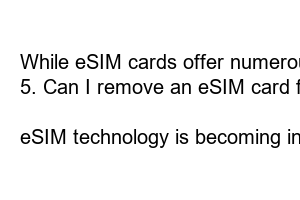유심 이심 차이
Title: The Difference Between SIM Card and eSIM Card: Simplifying Mobile Connectivity
Introduction:
In this digital era, our mobile devices have become indispensable tools for communication and staying connected. Central to this connectivity is the SIM card, a small but mighty component that enables our phones to connect to cellular networks. However, with the emergence of eSIM cards, confusion might arise as to the distinction between the two. This blog post aims to elucidate the key differences between a traditional SIM card and an eSIM card, highlighting their respective functionalities and benefits.
Subheadings:
1. What is a SIM Card?
A SIM (Subscriber Identity Module) card is a small, removable card used in mobile devices to establish and authenticate connections with cellular networks, effectively identifying the user’s account and phone number. It stores relevant data like the International Mobile Subscriber Identity (IMSI) and encryption keys.
2. What is an eSIM Card?
Unlike the physical nature of a traditional SIM card, an eSIM card, or embedded SIM card, is built directly into a device’s hardware. It offers the same functionality as a physical SIM card but eliminates the need for a physical swap when switching between carriers or services.
3. How Do They Differ in Usage?
Using a traditional SIM card involves manually inserting the card into the SIM card slot, providing flexibility to switch between different devices. On the other hand, an eSIM card is linked to a device at the manufacturing stage, simplifying the activation process by enabling users to connect to multiple networks remotely without changing physical cards.
4. What are the Advantages of a Traditional SIM Card?
The physical SIM card provides greater compatibility across devices, allowing users to easily switch between different smartphones. It also enables easy swapping between carriers and sharing plans, making it a versatile choice for frequent travelers or those who prefer owning their device outright.
5. What are the Benefits of an eSIM Card?
With an eSIM card, users can enjoy hassle-free activation and save space by eliminating the need for a physical card. It allows for selecting and activating a plan from supported carriers through easy-to-use interfaces, promoting greater convenience and flexibility.
6. Is Security Compromised with eSIM Cards?
Security is an essential aspect when it comes to mobile devices. Both traditional SIM cards and eSIM cards employ encryption technologies to protect personal data. eSIM cards even offer additional security features by allowing tamper-proof hardware integration, making them equally reliable in terms of safeguarding user information.
Summary:
In summary, SIM cards and eSIM cards play distinct roles in ensuring mobile connectivity. Traditional SIM cards offer versatility and compatibility but require physical swapping, while eSIM cards provide ease of use, remote activation, and space-saving benefits. Both options prioritize security and unlock the potential for seamless, tailored connectivity in an increasingly mobile-dependent world.
FAQs:
1. Can I use my existing SIM card with an eSIM device?
No, eSIM devices have built-in eSIM technology, requiring you to activate a new eSIM plan specifically designed for those devices.
2. How do I switch between carriers with an eSIM card?
With eSIM cards, you can easily switch carrier plans through the device’s settings, eliminating the need for physical card swapping.
3. Can I transfer my phone number to an eSIM card?
Yes, you can transfer your phone number to an eSIM card, allowing for seamless transition while retaining your existing number.
4. Will eSIM cards replace physical SIM cards entirely?
While eSIM cards offer numerous benefits, physical SIM cards currently offer more flexibility and compatibility, making them unlikely to be replaced entirely in the near future.
5. Can I remove an eSIM card from a device?
eSIM cards are embedded into the device’s hardware and cannot be physically removed or transferred between devices.
6. Are eSIM cards available on all devices?
eSIM technology is becoming increasingly common but is still not supported by all devices. It is essential to check device compatibility before considering an eSIM card option.

